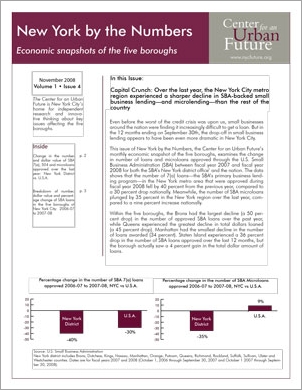Click here to read the full report (PDF).
Even before the worst of the credit crisis was upon us, small businesses around the nation were finding it increasingly difficult to get a loan. But in the 12 months ending on September 30th, the drop-off in small business lending appears to have been even more dramatic in New York City.
This issue of New York by the Numbers, the Center for an Urban Future's monthly economic snapshot of the five boroughs, examines the change in number of loans and microloans approved through the U.S. Small Business Administration (SBA) between fiscal year 2007 and fiscal year 2008 for both the SBA's New York district office and the nation. The data shows that the number of 7(a) loans—the SBA's primary business lending program—in the New York metro area that were approved during fiscal year 2008 fell by 40 percent from the previous year, compared to a 30 percent drop nationally. Meanwhile, the number of SBA microloans plunged by 35 percent in the New York region over the last year, compared to a nine percent increase nationally.
Within the five boroughs, the Bronx had the largest decline (a 50 percent drop) in the number of approved SBA loans over the past year, while Queens experienced the greatest decline in total dollars loaned (a 45 percent drop). Manhattan had the smallest decline in the number of loans awarded (34 percent). Staten Island experienced a 36 percent drop in the number of SBA loans approved over the last 12 months, but the borough actually saw a 4 percent gain in the total dollar amount of loans.


